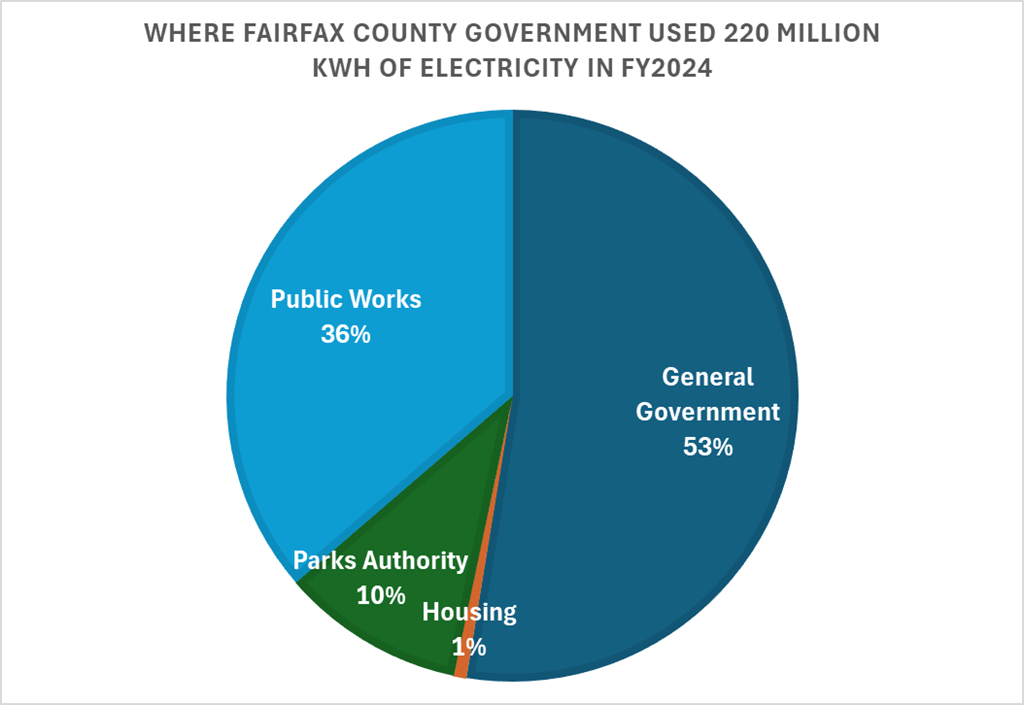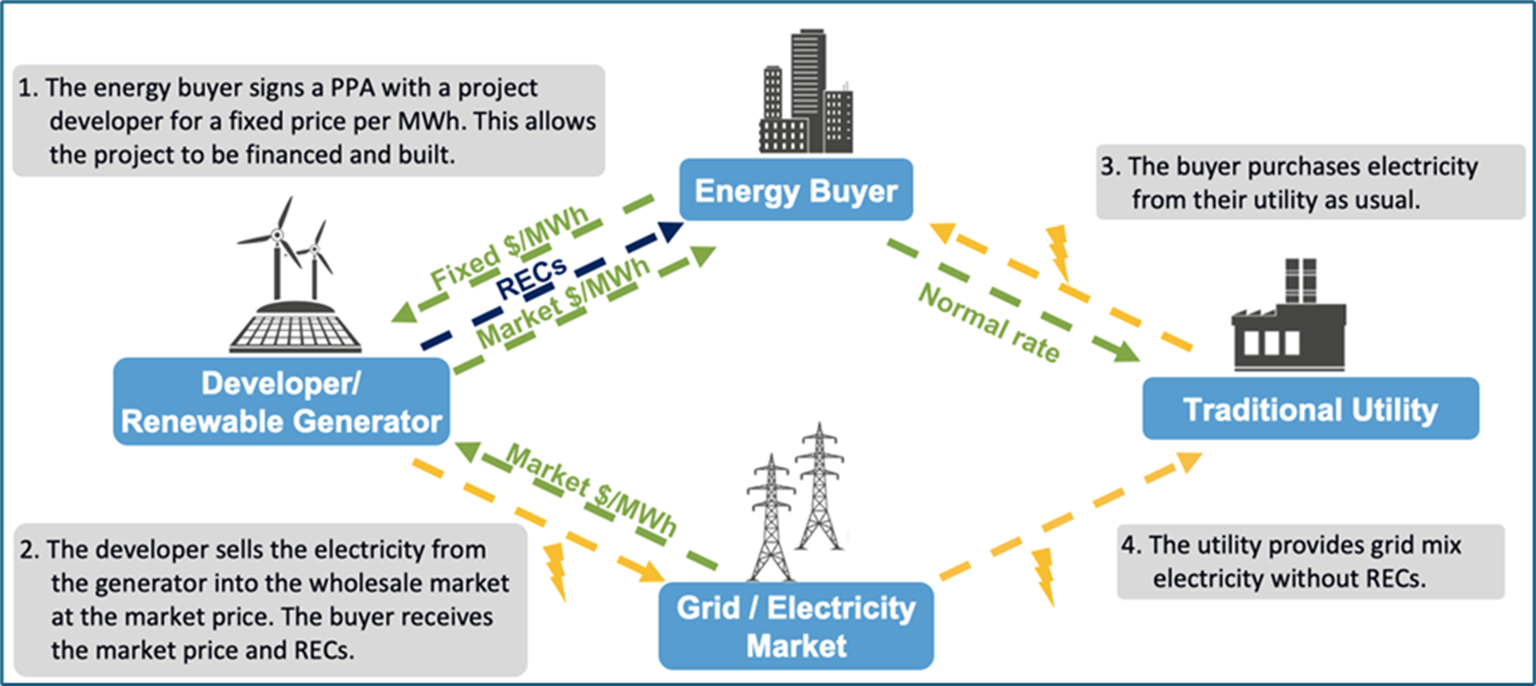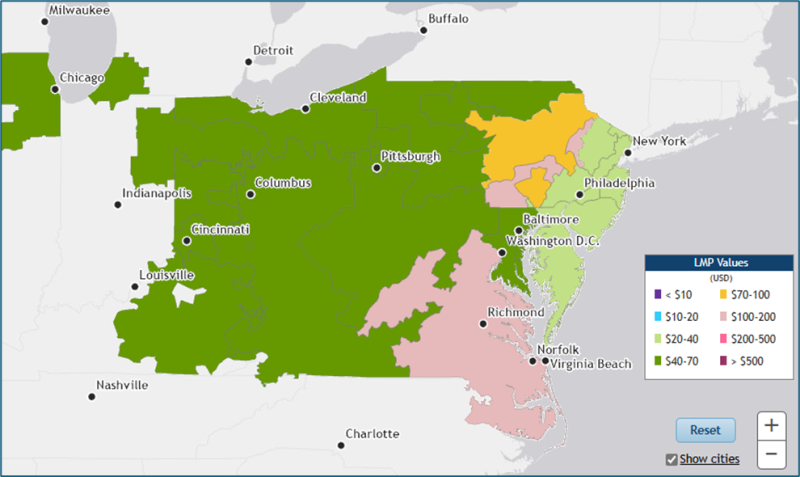Written by John Morrill, Director, OEEC
On June 18, Fairfax County celebrated the groundbreaking for the construction of a large (5 megawatts!) solar array on the closed Lorton Landfill. This project is by far the largest solar project underway by Fairfax County government and is the largest solar installation on a landfill in the Commonwealth of Virginia.
While impressive, the estimated 10 million kilowatt-hours (kWh) of electricity generated each year from that project will provide less than 5 percent of the total electric power needs of the county government. There is simply not enough roof area or suitable ground at government facilities to fulfill the county government’s goal of 25 percent of electricity from renewable sources by 2030 (and 50 percent from renewables by 2040) with onsite solar installations. Therefore, the county is considering a new way to buy renewable power – through a virtual power purchase agreement (VPPA).
Read on to learn more about where the county government uses electricity, how a VPPA works, and how this approach could help satisfy the county’s goal for renewable power.
County Energy Usage
With over 500 buildings and over 50,000 streetlights, the sheer number of facilities providing public services require a lot of power. In addition to office buildings, libraries, and fire stations, the county’s portfolio includes energy-intensive aquatic facilities at six Fairfax County Park Authority (FCPA) Rec Centers, and the county operates the Noman M. Cole Jr. Water Recycling Facility around the clock to clean 40 million gallons of wastewater every day.
Yet, in spite of our immense energy needs, we have steadily reduced our total energy use through energy efficiency projects in our buildings and facilities and the conversion of thousands of streetlights to energy-efficient LED technology. In total, the county government (including FCPA but excluding Fairfax County Public Schools) consumed over 220 million kWh in Fiscal Year 2024, down from over 260 million kWh in FY2018.
The pie chart in Figure 1 shows electricity use by major agency type.
How a VPPA Can Get Us to Our Green Energy Goals
In a VPPA, a customer signs a contract to purchase a certain portion of the electricity generated from a substantial new renewable energy installation.
Figure 2 shows the flow of electricity, money, and the renewable energy certificates (RECs) that are essential to document the ownership of renewable electricity.
Many major corporations and universities have entered into these VPPA transactions to generate new clean electric power and offset the carbon from their own grid electricity purchases. For example, utility-scale solar and wind farms are typically over 100 megawatts (MW) in capacity, providing hundreds of millions of kWh each year. Google claims to match their worldwide electricity consumption with renewable energy generation through agreements with many renewable energy farms around the world.
Arlington County entered a VPPA agreement in 2020 with Dominion Energy, but now that Dominion needs to keep renewable energy credits from clean power projects for their own compliance with the Virginia Clean Economy Act, Fairfax and others are seeking project development partners beyond Dominion.

A VPPA can involve a single customer purchasing all the electricity generated by a renewable energy farm, though the electricity will not be delivered to their facilities. Instead, in a VPPA, the electricity goes to the grid, while the customer retains the RECs. The customer agrees to a fixed price, such as $0.05 per kilowatt-hour (kWh). The key feature of a VPPA is that it is a contract for differences, which means the actual net cost to the customer will be the difference between the fixed price the customer negotiates with the seller and the real-time price the seller receives from the wholesale power market for the electricity the renewable energy farm produces.
The wholesale price of electric power varies based on the use of power and the available supply. In our region, the electric grid is managed by an entity called the PJM Interconnection.
Figure 3 shows a screenshot from the PJM website illustrating the wholesale price of electric power at a particular time on a recent day.
To illustrate this transaction, if a solar energy farm was selling electricity into the wholesale market in portion of Virginia with pink color at the time shown in the image of Figure 3 –
- The solar farm would receive over $100/MWh (or over $0.10/kWh) for that power.
- If that farm had a customer who had agreed to pay a fixed $0.05/kWh for all electricity generated, then the customer would enjoy a net credit of over $0.05/kWh for that power generated during that time.
On the other hand, if the renewable energy farm was located on the Eastern Shore of Virginia, colored light green in the Figure 3 –
- The solar farm would receive less than $40/MWh for the power, and
- The VPPA customer would pay the farm the net cost of the difference between $0.05/kWh fixed price and whatever the farm got from the market for the power generated during that time.

The long-term contracts in a VPPA are designed to provide assurance to the renewable energy farm developer that they will have a guaranteed income stream. The customer seeks to have an agreement that is revenue/cost neutral over the long term. There will be some hours and days that the solar farm is producing power at a ‘profit’ for the customer, which would offset any hours and days that the customer has a ‘loss’ due to low wholesale prices.
Pursuing a VPPA for Fairfax County
Fairfax County is investigating options for a VPPA either through its own Request for Proposals or through a collaborative arrangement with other localities. The goal is to pursue one or more contracts at new renewable energy farms to generate enough power (represented through renewable energy certificates) to offset 25 percent or more of the county’s electricity use. Of course, the long-term financial viability of each transaction will be carefully vetted before the county would enter into such a transaction.
While the county looks forward to the green power to be generated from the landfill site, we will continue to pursue solar on other government sites where appropriate and cost-effective. A VPPA will provide a much more substantial contribution toward our green power goals at minimal net cost to the county.

John Morrill has over 35 years of experience in energy and environmental issues including serving as director of the OEEC since March 2023. Prior to joining Fairfax County, he led Arlington County’s climate action program and worked on energy management there for 20 years. He began his professional career with the American Council for an Energy-Efficient Economy (ACEEE).
Climate Matters is the blog of Fairfax County’s Office of Environmental and Energy Coordination, where we share stories, insights and information related to climate change and environmental sustainability. Posts are written by knowledgeable and passionate OEEC staff members and guest authors. To read all blog posts, visit Climate Matters.

